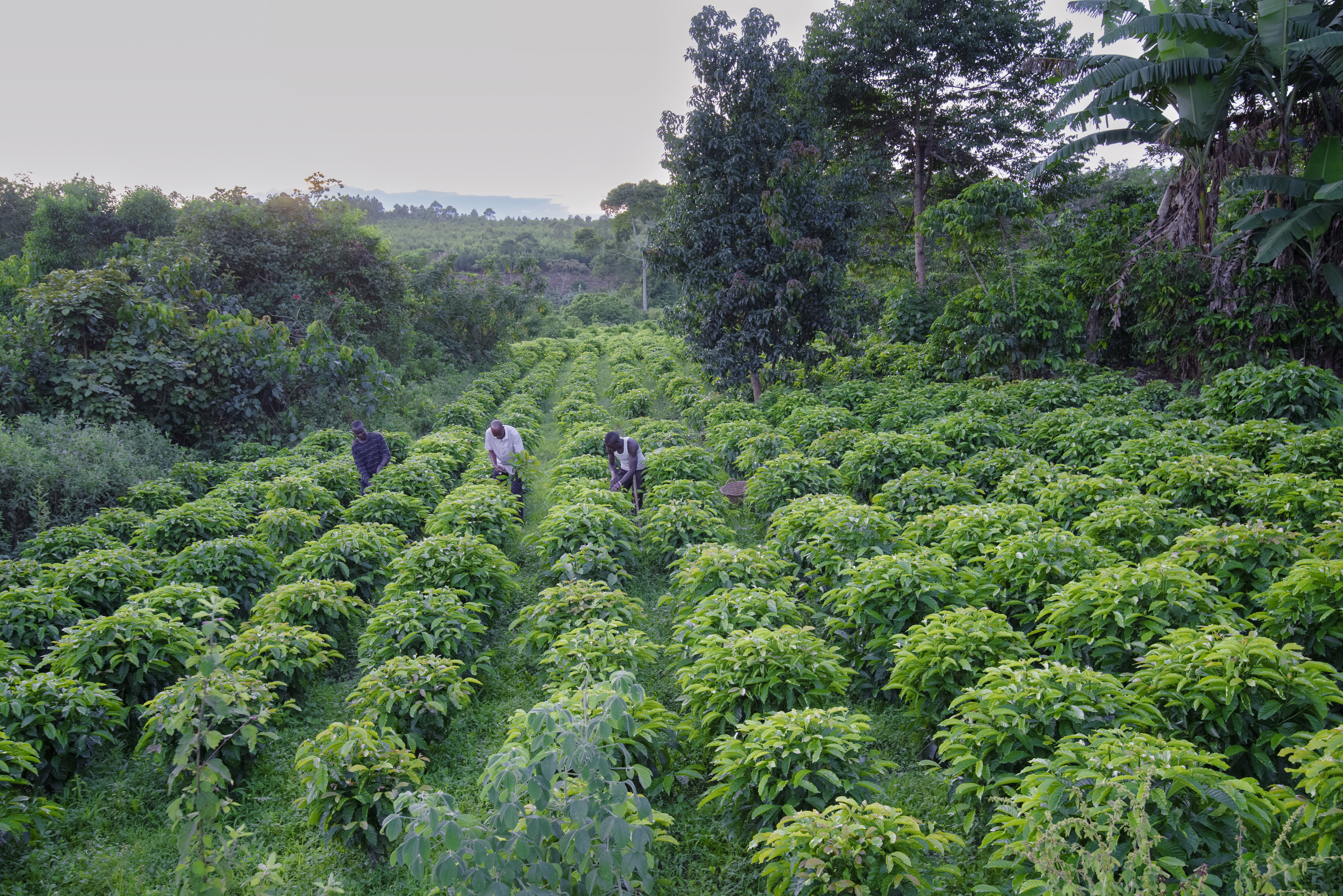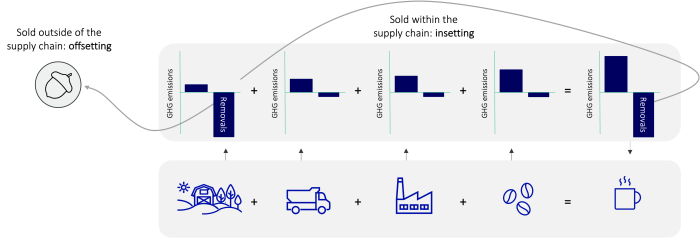
A new way to compensate emissions
Insetting, a unique solution in which we support traders and roasters to make matches between farmers they are sourcing from and that are part of the Acorn program. By this, companies can purchase carbon removal units (CRUs) generated through Acorn by farmers in their own value chain, which these companies can use for an Insetting proposition.
Crucially, 80% of each CRU’s revenue flows back to the original smallholder: the whole supply chain moves forward, planting the seed for a greener, cooler, more sustainable planet.


Insetting: how it works
Supply chain benefits
Insetting drives decarbonization throughout the supply chain, and allows companies to partner with other players in the chain to collectively reduce (remove) net emissions.
The companies decide on how they would like to use the Carbon Removal Units; either for 1) Offsetting; as removals on their companies’ emissions or for 2) Insetting; together with the rest of the value chain to remove emissions on the produce
We offer an additional advantage: providing first right of refusal for purchasing the CRUs generated by a company's supply chain.

Transparency benefits
Our proven origin, nature-based credits are reliable and transparent, with the Acorn registry featuring detailed information on where the carbon removal has taken place, down to a single plot.
High-quality measurement, quantification, verification, and certification of carbon removals within the value chain at very low costs make insetting a more viable option.

Co-benefits
Insetting enables companies to develop strong, long-term relationships with farmers and improve farmer livelihoods by unlocking additional income streams for them.
With Acorn covering cost-efficient measurement, certification, validation, and monitoring carbon removal with 10% of CRU value, smallholder farmers benefit most (80%).
Meanwhile, companies who purchase Acorn’s CRUs contribute to SDGs 1,2, 6, 8, 12, 13, 15, and 17, while improving soil, supporting biodiversity, and empowering local communities.

Get in touch
Interested in collaborating with Acorn? Contact us and our team will be in touch shortly.
More information about our CRUs
We believe in our mission and commit ourselves to empowering smallholder farmers and fighting climate change. That also means that we want the organizations who buy our credits to make a real effort, and not just buy a few carbon credits and tick a box.
To be eligible to purchase Acorn CRUs organizations must meet the following criteria:
1. Organizations should qualify as a business user and not a consumer.
2. Organizations must not be active in any of the following sectors:
oil and gas;
aviation;
mining, or;
other fossil fuels industries (this does not include power generation utilities who use fossil fuels to generate electricity for consumption).
3. At least one of the following measures should be in place:
a committed science-based target (SBTi) aligned to limiting a global temperature increase to 1.5 degrees;
is part of the Net Zero Banking Alliance;
a written strategy in place to reduce greenhouse gas emissions (publicly available or available to Rabobank); reductions should be in line with the industry target of the SBTi standard;
proven greenhouse gas reduction (publicly available or available to Rabobank), in line with the industry targets of the SBTi standard.
Furthermore, all Third-Party buyers must comply with the Rabobank Sustainability Statement, or have a similar type of policy in place.
Each and every Acorn CRU you buy:
Represents one tonne of CO2;
Is certified by Plan Vivo;
Denotes removal offsets (not avoidance, reduction or allowance credits);
Is ex-post—the carbon is sequestered before the CRU is generated, not a promise for the future;
Provides a nature-based solution—we use agroforestry methods rather than technological solutions like direct air capture;
Is derived from projects that exclusively cover smallholder farmers (<10 ha) in developing countries;
Is transparent, measured with remote sensing and traceable —we show when, where and by whom the carbon is sequestered, all the way down to the individual plot and farmer level;
Features a durability period of 20 years—this is the period during which the CO2 represented by a CRU is expected to remain removed from the atmosphere or sequestered in the buffer pool;
Is backed by a buffer pool put in place as insurance for reversal events;
Guarantees 80-90% of the sale price flows directly back to the smallholder farmer;
Contributes to UN Sustainable Development Goals 1, 2, 6, 8, 9, 13, 15, 17.
Has a minimum price of EUR 20;
As CRU prices fluctuate, we can only provide an indication of our recent transaction price of €35 (updated Oct-2023). No rights can be derived from this information.
Every Acorn CRU represents one metric tonne CO2, which is intended to be:
Net of any leakage,
Removed from the atmosphere as a result of the biomass growth in agroforestry projects,
Additional to any GHG reduction that would occur in the base of the projects
Stored or otherwise sequestered during the durability period.
The durability period is the period during which the CO2 represented by a CRU is expected to remain removed from the atmosphere or sequestered in the buffer pool. For our CRUs this currently is monitored for 20 years since its creation.
To support durability, we have created a buffer pool by setting aside 15% of the CRUs issued. In case of unexpected, premature release of carbon stock (e.g. through forest fires or illegal logging), CRUs are replaced from the buffer pool (which is not unlimited). These replacement CRUs are referred to as buffer pool CRUs. The buffer pool is managed by Rabobank with third-party oversight from the Plan Vivo Foundation. For avoidance of doubt, Acorn’s reversal obligation is capped to the CRUs available in the buffer pool.
CRUs are calculated following the Acorn methodology. CRUs are based on the values of above ground biomass in a certain plot, derived from satellite images and ground truth data using predictive machine learning models.
To generate CRUs we use machine learning carbon models to measure the above ground biomass. The carbon models are developed from a combination of sample plot ground truth measurements and satellite imagery for a specific ecoregion. The models make an estimate of the total biomass of a certain plot. Data from sample plots is used to calibrate the models. The minimum accuracy of the models is 70% and is compensated for with an uncertainty adjustment factor. All models are validated – see Certification | Acorn Rabobank for more information.
For a full description of our process and all details of the models and formulas used, have a look at the Acorn framework and methodology. Both are publicly available on our website and both have been under public consultation.
The Acorn Framework describes our approach and the Plan Vivo certification process and requirements for every Acorn CRU.
The Acorn Methodology describes the processes involved when measuring and calculating carbon removal units. The Methodology has been externally assessed and approved by two accredited validation and verification bodies: SCS Global Services and AENOR.
Buyers have a committed science based target (SBTi) aligned to limiting a global temperature increase to 1.5 degrees and/or a written strategy in place to reduce its GHG emissions and/or a proven GHG reduction (publicly available or available to Rabobank) and purchases Acorn CRUs to compensate unavoidable GHG emissions from its activities.